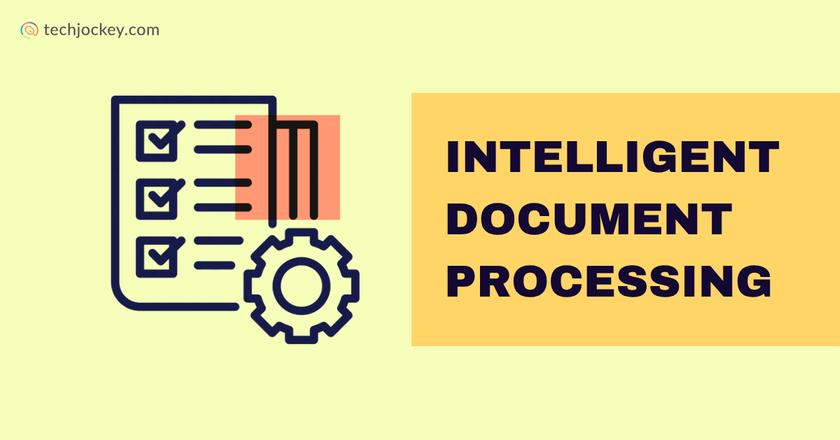How Intelligent Document Processing Improves Business Efficiency with AI?

Quick Summary
- Intelligent Document Processing (IDP) helps extract data from documents, speeding up business document processing.
- Works with all types of documents: forms, invoices, mail, and more.
- Saves time by automating data entry and performing automatic checks.
- Used across industries like finance, healthcare, and HR.
- Now integrated with generative AI for smarter insights and document summaries.
Did you know that many enterprises deal with almost 80% unstructured data? It is scattered everywhere around emails, PDFs, invoices, notes, forms, and contracts.
What issue arises with this?
The answer is that it makes data inaccessible to most business systems, which makes business workflows complicated.
From using OCR technology to now entering generative AI, IDP has come a long way.
Intelligent Document Processing uses automation to make document scanning and understanding data easier than before.
Confused?
Let’s understand it in simple terms.
What is Intelligent Document Processing (IDP)?
Intelligent Document Processing (IDP) is a kind of technology that integrates artificial intelligence document processing, machine learning, and natural language processing to read, comprehend, extract, classify, and process the data present in different types of documents.
It’s not like traditional ways of extracting data, like OCR tools. IDP works with all types of documents:
- Structured ones, such as forms/spreadsheets
- Semi-structured invoices or purchase orders
- Unstructured documents that include emails, handwritten notes, contracts, etc.
In very simple terms, intelligent document processing reads any format document and handles data entry for you. It’s accurate and fast.
A Quick Look at the Evolution of IDP
Document processing journey has upgraded with time with new technologies. Here’s a look:
- Entering data manually: It was when all the data had to be entered manually. Still, people do it, but it consumes a lot of time.
- OCR Software: It’s still in use and is used to turn scanned text into machine-readable text. OCR software is useful but is limited in its capabilities.
- Intelligent Document Processing: Next came IDP. It has more added capabilities by using AI, ML, and NLP. It not only extracts text but also understands and acts on it.
- Generative AI & LLMs: It’s an add-on to IDP. It understands data and generates insightful summaries also and suggests what can be done next.
With this evolution of intelligent document automation, you can do more than what was previously impossible.
How Does Intelligent Document Processing Work?
Here are a few pointers to understand the working of intelligent document processing:
1. Document Ingestion
The system ingests documents from various sources:
- Scanned images
- Web portals
- Enterprise systems
- Mobile uploads
Formats can include PDF, Word, images (JPG, PNG), or even handwritten paper.
2. Preprocessing
Next is document cleaning using computer vision. It includes adjusting contrast, removing noise, and deskewing it so text is properly aligned.
3. Intelligent Document Recognition & Classification
Here, it uses deep learning. IDP systems recognize the type of document using trained models. It finds whether it’s an invoice, contract, resume, or pay stub.
Some tools are capable of understanding 190+ languages, making them usable worldwide.
Classification is crucial because it helps in knowing which rules or models to apply next.

Nanonets OCR
Starting Price
$ 499.00
4. OCR and Intelligent Data Extraction
Here comes the role of OCR software – a key technology in IDP. OCR (Optical Character Recognition) converts printed or handwritten text into digital characters.
But today, it’s not just simple OCR. There are four types:
- Standard OCR: This compares the scanned text to known fonts/templates.
- Intelligent Character Recognition (ICR): This is the one that uses machine learning algorithms to comprehend different handwritings and fonts.
- Intelligent Word Recognition (IWR): Again, as the name suggests, it recognizes the context of every word.
- Optical Mark Recognition (OMR): It identifies symbols or check boxes, logos, or watermarks present in the document.
When these three technologies are used in combination, everything becomes extracted clearly, even when the layout varies per document.
5. Natural Language Processing (NLP)
Once the text is extracted, NLP helps understand its context. For example:
- What’s the due date on this invoice?
- Who is the vendor?
- Is this contract renewal automatic?
NLP combines:
- Semantic & syntactic analysis (computational linguistics)
- ML for grammar/colloquialisms/sarcasm
- Deep learning for complex pattern recognition
It’s especially powerful for extracting meaning from emails, contracts, or support tickets.
6. Data Validation
The extracted data is then validated. This might involve:
- Matching against a purchase order system
- Ensuring invoice amounts add up correctly
- Flagging mismatches based on business rules
7. Workflow Automation & Integration
Once the data is validated, the clean data moves to downstream systems like ERP, CRM, HRMS, etc. With the help of RPA (Robotic Process Automation), many tasks like updating records, initiating payments, or sending alerts are automated.

Laserfiche
Starting Price
Price on Request
8. Continuous Learning
This is what makes IDP intelligent. With each document processed, the system learns:
- Common errors
- Format variations
- User feedback
This learning makes IDP more accurate and adaptable over time.
9. Reporting & Analytics
Modern IDP tools track metrics such as:
- Processing speed
- Error rates
- Types of flagged issues
- Document volume trends
These insights help teams optimize workflows and improve business decisions.
Key Technologies Behind IDP
Here’s a summary of core technologies that make IDP work:
| Technology | Role |
|---|---|
| OCR Software | Converts scanned or image-based text into machine-readable format |
| ICR / IWR / OMR | Recognizes handwriting, words, symbols, and marks |
| NLP | Understands language, context, and sentiment |
| ML Models | Learn and adapt to new layouts and formats |
| Computer Vision | Enhances scanned images and detects structure |
| RPA | Automates repetitive tasks post-processing |
IDP vs. Automated Document Processing
People often get confused between these two terms, but what if I tell you they are different? Let’s understand:
- Automated Document Processing: Focuses mainly on digitizing paper – creating searchable, indexed documents. Good for archiving.
- Intelligent Document Processing: Goes far beyond. It reads, understands, and acts on the data. It’s a complete business process automation tool, not just a digitizer.
So, while automated processing makes data accessible, IDP makes it actionable.
Why Businesses are Investing in IDP?
Let’s get practical. Here are the key benefits of adopting IDP:
- Better Accuracy: IDP reduces human error drastically. While manual entry has an error rate of 3–5%, IDP accuracy often exceeds 95% and improves with time.
- Huge Cost Savings: Manual document processing costs $6–$8 per document. With IDP, this can drop by 70–90%.
- Time Efficiency: Documents are processed in seconds, freeing up employees from hours of data entry.
- Scalable Operations: From 100 to 1 million documents, IDP handles it all without the need to expand teams.
- Improved Compliance: With full audit trails, document versioning, and data validation, companies meet regulatory standards more easily.
- Employee Satisfaction: Let people focus on meaningful work. IDP takes care of the repetitive stuff.

OnBase
Starting Price
Price on Request
Intelligent Document Processing (IDP) Use Cases
IDP is already making an impact across industries:
- In Healthcare, you can extract patient information from medical records. It helps you digitize prescriptions and lab reports. You can also automate insurance claim validations.
- Finance teams can automate invoice processing and save time. You can create expense reports and also extract data from receipts and Pos.
- Legal firms can analyze contract clauses with NLP. You can extract deadlines and obligations, and also process court records for litigation.
- In Logistics, it helps with processing shipping documents, validating customs permits, tracking inventory and delivery slips, and more.
- The human resource team can parse resumes and candidate profiles, automate payroll inputs, extract leave records, and timesheets.
Challenges with IDP And How They’re Being Solved
Every technology comes with its own set of challenges. IDP is no different. Some common roadblocks include:
- Dealing with poor-quality scans
- Understanding regional languages or handwriting
- Frequent changes in document formats
- Security and data privacy concerns
However, modern IDP solutions are overcoming these through:
- AI-powered image enhancement
- Multilingual NLP engines
- Continual learning models
- Role-based access and encryption protocols
So while IDP isn’t perfect, it’s upgrading itself fast and becoming smarter and more adaptable with each passing year.

TextSnap
Starting Price
$ 3.00
The Future of IDP
With the rise of Large Language Models (LLMs) and Generative AI software, IDP is entering a new era.
Now, IDP can:
- Summarize documents
- Translate across languages
- Identify tone, urgency, or risk
- Generate structured reports from raw data
This next wave of IDP means that even unstructured and contextual documents can be processed intelligently at scale.
Final Thoughts
If you are a small company dealing with 50 invoices per month or a large one that has to extract data from thousands of emails, IDP is going to help you.
It saves your time, money, and effort. What could be better than this?
With technologies like OCR, NLP, ML, and AI running in the background, you get everything at your fingertips.
Now, the question is:
If your competitors are adopting IDP, can you afford not to?
Mehlika Bathla is a passionate content writer who turns complex tech ideas into simple words. For over 4 years in the tech industry, she has crafted helpful content like technical documentation, user guides, UX content, website content, social media copies, and SEO-driven blogs. She is highly skilled in... Read more


















